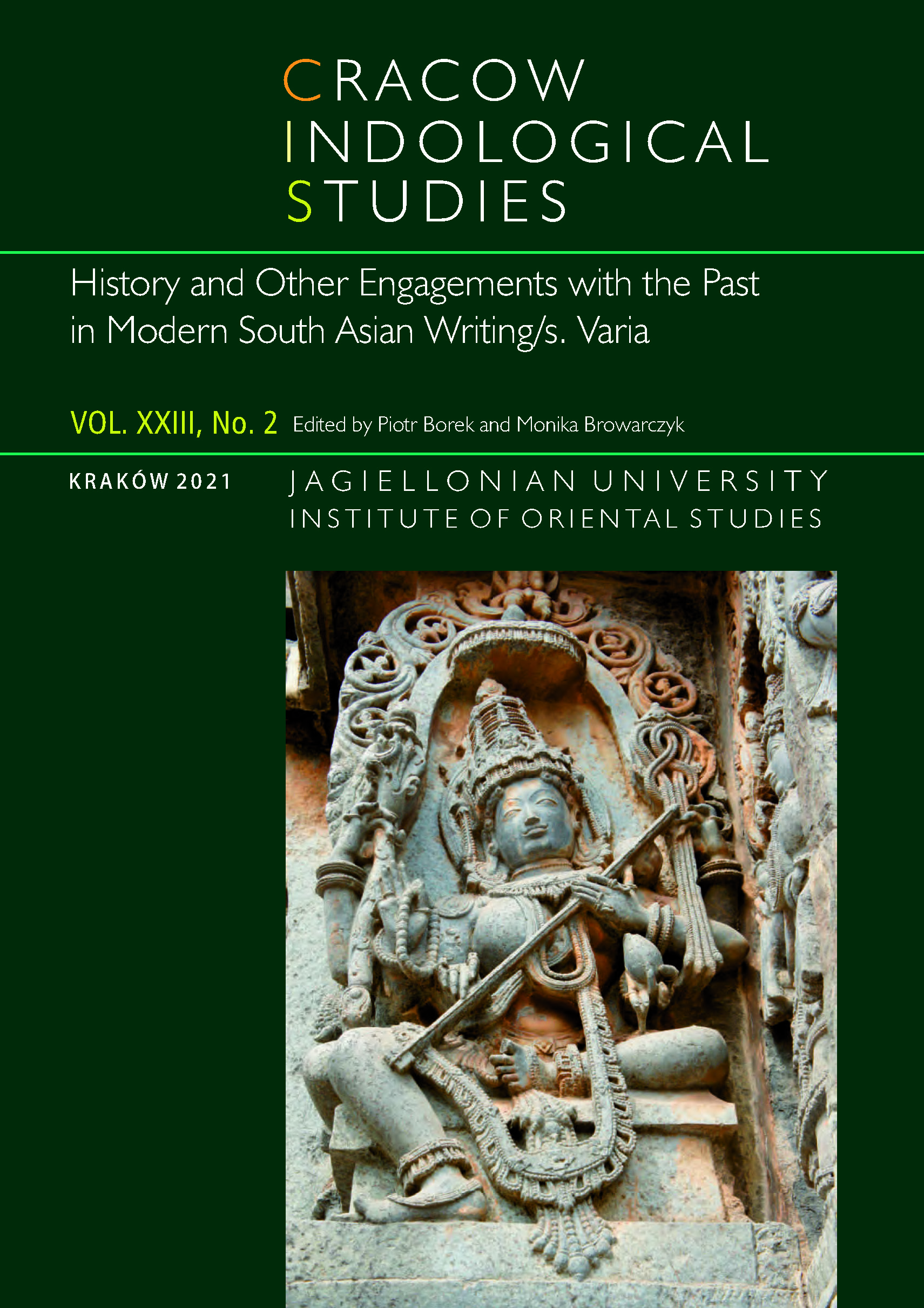The Worship of the Goddess of Language: Ram Mani Acharya Dixit’s Efforts in Standardization of the Nepali Language in Benares
DOI:
https://doi.org/10.12797/CIS.23.2021.02.07Keywords:
Standardization of Nepali, Nepali print history, deification and embodiment of the language, linguistic nationalism, Nepali language movement in BenaresAbstract
This paper will focus on a 20th century Nepali intellectual, Ram Mani Acharya Dixit (1883–1972), and his trans-border activities for the promotion of the vernacular by investigating his integration of the progress of a language with his nation, his apotheosis of the vernacular and his devotion in strengthening prose writing for the sake of the development of the divine mother tongue. Foregrounding his linguistic activities such as writing, publishing and printing in Nepal and India, with Benares in particular, it will try to answer questions such as: What was the motivating factor that inspired him to write and publish in the Nepali language? Was he in any way influenced by the Hindi language movement that was at its peak in North India of the time? How influential was Dixit’s role in standardizing Nepali? Besides this Nepali language standardization concern, the paper will also examine Dixit’s idea of serving mother, motherland, mother tongue and [Hindu] religion through service to a language.
References
Ācārya Dīkṣit, K. 2043 v.s. Samjhanāko bāṭomā. Kathmandu: Shanti niketan pustakalaya.
Ācārya Dīkṣit, R. 2029 v.s. Purānā samjhanā. Kathmandu: Nalinī Devī Āchārya.
Ācārya Dīkṣit, R. 2072 v.s. Prācīn saṃsmaraṇ. Kathmandu: Shanti niketan pustakalaya.
Chalmers, R. A. M. 2018. ‘We Nepalis:’ Language, Literature and the Formation of a Nepali Public Sphere in India, 1914–1940. Ann Arbor: ProQuest LLC.
Chalmers, R. A. M. 2002. Pandits and Pulp Fiction: Popular Publishing and the Birth of Nepali Print Capitalism in Banaras. In: Studies in Nepali History and Society, 7(1): 35–97.
Bhaṭṭarai, Ś. Ś., R. Śarmā and Ś. Regmī. 2060 v.s. Motirām Bhaṭṭa ra samsargī kavi. Kathmandu: Royal Nepal Academy.
Chudal, A. A. 2016. A Freethinking Cultural Nationalist: A Life History of Rahul Sankrityayan. Delhi: Oxford University Press. DOI: https://doi.org/10.1093/acprof:oso/9780199466870.001.0001
Chudal, A. A. 2014. Embodying Nepal’s Geography: Imagery of the Earth and the Sun in Nepali Poetry. In: Pandanus. Nature in Literature, Art, Myth and Ritual, 8(2): 47–64.
Chudal, A. A. 2077 v.s. Nepālī sāhityako itihāsma kāśī. In: A. A. Chudal (ed.) Uttar Bhārat ko nepālī sāhitya. In: M. P. Pokhrel (ed.) Jagadambā nepālī sāhityako bṛhat itihās, vol. 3. Lalitpur: Kamalmani Prakashan: 402–431.
Chudal, A. A. 2021. Nepali Intellectuals in Exile: The History of Nepali Printing in 19th- and 20th-Century Benares. In: Journal of South Asian Intellectual History, 3(1): 34–59. https://doi.org/10.1163/25425552-12340020. DOI: https://doi.org/10.1163/25425552-12340020
Dahal, M. 2019. Lahaḍbājīmā varṇavinyāsko śiṣṭa paramparā bhatkāekāle nepālī bhāṣā arājakatāko sikār hunapugyo: śaraccandra vastī. In: Rātopāṭi, https://ratopati.com/story/104892/2019/11/2/osti-interview?fbclid=IwAR1GT2SCqIh3QPQJGOaNZOQPcK5MP7_tLCN-XMzygefSsmS8YRBlhi12dbE, accessed on 9.01.2021.
Dīkṣit, K. 2041 v.s. Birseko samjheko. Lalitpur: Jagadamba prakashan.
Dīkṣit, K. 2039 v.s. Saglo ākār -halanta bahiṣkār. In: B. Pokhrel (ed.) Paccis varṣakā bhaṣik carcā. Kathmandu: Royal Nepal Academy: 24–32.
Dīkṣit, K. 2040 v.s. Jaṅga-gītā. Lalitpur: Jagadamba prakashan.
Gaenszle, M. 2011. Emergent Nationalism, Citizenship, and Belonging among Nepalis in Banaras: The Case of Kashi Bahadur Shrestha. In: J. Pfaff-Czarnecka and G. Toffin (eds.). The Politics of Belonging in the Himalayas: Local Attachments and Boundary Dynamics, ed. by Governance, Conflict, and Civil Action, vol. 4. New Delhi: SAGE Publications India: 201–221. http://dx.doi.org/10.4135/9788132107729.n10. DOI: https://doi.org/10.4135/9788132107729.n10
Gopal, M. 1972. Mahavir Prasad Dwivedi: A Maker of Modern Hindi. In: Indian Literature, 15(1): 27–37.
Grierson, G. A. 1916. Linguistic Survey of India, vol. IV: Indo-Aryan Family: Central Group, Part IX: Specimens of the Pahari Languages and Gujuri.
Calcutta: Superintendent of Government Printing, http://dsal.uchicago.edu/books/lsi/lsi.php?volume=9-4&pages=998#page/1/mode/1up, accessed on 9.02.2017.
Gupta, C. 2001. The Icon of Mother in Late Colonial North India: ‘Bharat Mata,’ ‘Matri Bhasha’ and ‘Gau Mata.’ In: Economic and Political Weekly, 36(45): 4291–4299. DOI: https://doi.org/10.1057/9780230108196_5
Hutt, M. J. 1988. Nepali: A National Language and Its Literature. London: SOAS.
Nepāl, J., 2057 v.s. Paṃ hemrāj śarmā: unkā kṛti ra samīkṣā. Dang: Mahendra sanskrit vishvavidyalaya.
Nepāl, Ś. 2050 v.s. Rāmmaṇi ā. dī.: vyakti ra kṛti. Kathmandu: Srijana prakashan.
Onta, P. 1996. Creating a Brave Nepali Nation in British India: The Rhetoric of Jāti Improvement, Rediscovery of Bhanubhakta and the Writing of Bīr History. In: Studies in Nepali History and Society, 1(1): 37–76.
Orsini, F. 2010. The Hindi Public Sphere 1920–1940: Language and Literature in the Age of Nationalism. New Delhi: Oxford University Press. DOI: https://doi.org/10.1093/acprof:oso/9780198062202.001.0001
Orsini, F. 2004. Pandits, Printers and Others: Publishing in Nineteenth-century Benares. In: A. Gupta and S. Chakrovorty (eds.). Print Areas Book History in India. Delhi: Permanent Black: 103–138.
Rai, H. 1908. Mīthā mīthā nepālī gīt. Darjeeling: Gorkha press.
Rai, H. 1908. Bihāko ślok. Darjeeling: Gorkha press.
Rāj, P. A. 2057 [2035] v.s. Vidvacchiromaṇi hemrāj śarmā. Lalitapura: Sājhā prakāsanabāta.
Sama, B. 2054 v.s. Mero kavitāko ārādhanā. Lalitapura: Sājhā prakāsanabāta.
Siṃha, U. B. 2008. Mhāvir Prasād Dvivedi Aur Unkā Yug. Lucknow: Lucknow University.
Smith, S. and J. Watson. 2010. Reading Autobiography: A Guide for Interpreting Life Narratives, Minneapolis: University of Minnesota Press.
Śrestha D. B. and Ś. P. Paudyāl. 2077 v.s. Nepālī bhāṣā sāhityako vikāsmā kāśībāṭa prakāśit nepālī patrapatrikā ko bhumikā. In A. A. Chudal (ed.) Uttar Bhārat ko nepālī sāhitya. In: M. P. Pokhrel (ed.), Jagadambā Nepālī sāhityako br̥hat itihās vol. 3. Lalitpur: Kamalmani Prakashan: 432–440.
Stark, U. 2007. An Empire of Books: The Novel Kishore Press and the Diffusion of the Printed Word in in Colonial India. Ranikhet: Permanent Black.
Ramaswamy, S. 1997. Passions of the Tongue: Language Devotion in Tamil India, 1891–1970. Berkeley: University of California Press. https://doi.org/10.1525/9780520918795. DOI: https://doi.org/10.1525/9780520918795
Ramaswamy, S. 2001. Maps and Mother Goddesses in Modern India. In: Imago Mundi. The International Journal for the History of Cartography, 53(1): 97–114. https://doi.org/10.1080/03085690108592940. DOI: https://doi.org/10.1080/03085690108592940
Tripāthī, G. 2076 v.s. “Mādhyamik kālkā anya gadya vidhāko itihās.” In: K. Dikṣit and N. Gaḍtaulā (eds) Jagadambā Nepālī sāhityako bṛhat itihās vol. 2. Lalitpur: Kamalmani Prakashan: 816–828.
Whelpton, J. 1983. Jang Bahadur in Europe: The First Nepalese Mission to the West. Kathmandu: Sahayogi Press.
Downloads
Published
Issue
Section
License

This work is licensed under a Creative Commons Attribution-NonCommercial-NoDerivatives 4.0 International License.






